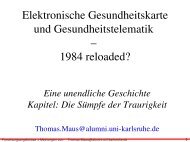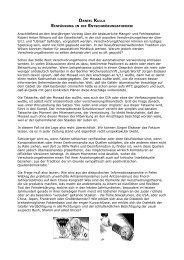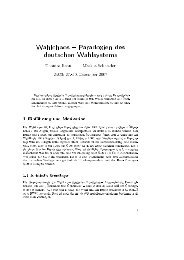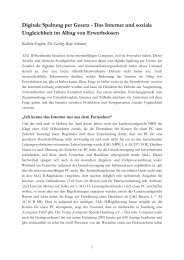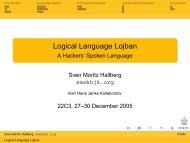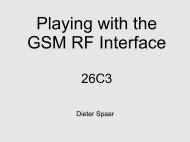Complete Hard Disk Encryption Using FreeBSD's GEOM Framework
Complete Hard Disk Encryption Using FreeBSD's GEOM Framework
Complete Hard Disk Encryption Using FreeBSD's GEOM Framework
You also want an ePaper? Increase the reach of your titles
YUMPU automatically turns print PDFs into web optimized ePapers that Google loves.
isk “phenomenon” – which will be discussed in chapter 2.3. In most cases, encryption is<br />
therefore either abandoned or the following, more effective and efficient scheme is<br />
chosen.<br />
2.2 Partition-based encryption<br />
Obviously, creating a temporary plain text copy of an entire partition each time the data<br />
is accessed, is hardly a sane solution. The system must therefore be able to perform the<br />
encryption and decryption onthefly, as it has been implemented in the FreeBSD kernel<br />
for GBDE [Kamp, 2003a] and GELI [Dawidek, 2005a] and cgd(4) in NetBSD<br />
[Dowdeswell & Ioannidis, 2003]. A few third party addons also exist. One example of this<br />
is the aforementioned vncrypt, which was developed at Sourceforge.<br />
vncrypt is, however, in a further sense still filebased, because the encrypted<br />
partition is only a mounted pseudodevice created via the vn(4) facility from a regular<br />
file. This file holds all the partition's data in encrypted form – including meta data.<br />
OpenBSD's vnconfig(8) provides a similar feature [OpenBSD, 1993].<br />
One aspect associated with partitionbased encryption is that its setup process is<br />
usually more extensive than it is for filebased encryption. But once it has been done,<br />
partitionbased encryption is far superior to the filebased encryption scheme. All data<br />
going to the particular partition is – by default – stored encrypted. As both encryption<br />
and decryption is performed transparently to the user and onthefly, it is also feasible to<br />
encrypt both large amounts of files and large amounts of data.<br />
But unfortunately, this scheme it not perfect either.<br />
2.3 The leakage risk<br />
As obvious as it may sound, partitionbased encryption protects only what goes onto the<br />
encrypted partition. The following scenario highlights the particular problem.<br />
Scenario: editing a sensitive document stored on an encrypted partition<br />
A mobile user needs to have a lot of data at his immediate disposal. Since some<br />
information is sensitive, he decides to put it on an encrypted partition.<br />
Unfortunately, the encryption becomes basically useless as soon as encrypted files<br />
are opened with applications that create temporary copies of the files currently being<br />
worked on, often in the /tmp directory. So unless the user happens to have /tmp<br />
encrypted, his sensitive data is leaked to an unencrypted part of the medium. Even if the<br />
application deletes the temporary copy afterwards, the data still remains on the medium<br />
until it is physically overwritten. Meta data such as file name, size and ownership may<br />
also have leaked and may therefore remain accessible for some time.<br />
This phenomenon happens equally implicitly with printing. Even if the application<br />
itself does not leak any data, the spooler will usually create a Postscript document in a<br />
subdirectory of /var/spool/lpd/, which is not encrypted unless specifically done so.<br />
Even though it is possible to symlink the “hot” directories such as /tmp, /var/tmp, as<br />
well as the complete /home or /var/spool/lpd/ to directories on the encrypted partition,<br />
the leakage risk can never be avoided completely. It is something that users of partitionbased<br />
encryption just have to be aware of and learn to live with by minimizing the<br />
amount of leaked data as much as possible.<br />
5



